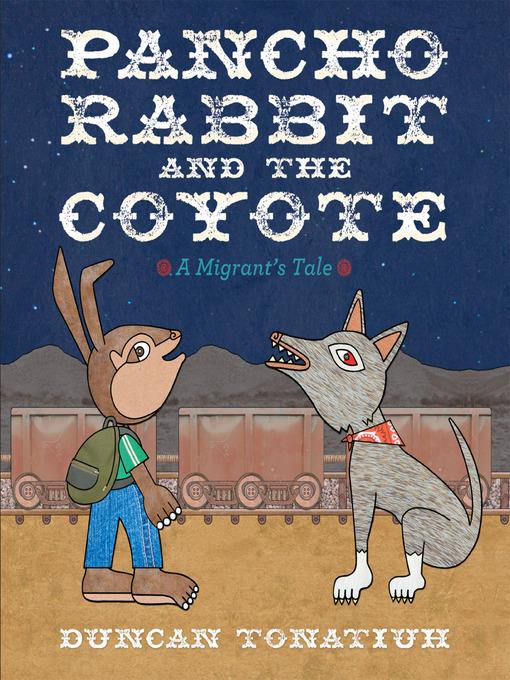
Pancho Rabbit and the Coyote
A Migrant's Tale
فرمت کتاب
ebook
تاریخ انتشار
2013
Lexile Score
590
Reading Level
2-3
ATOS
3.8
Interest Level
K-3(LG)
نویسنده
Duncan Tonatiuhناشر
ABRAMSشابک
9781613125724
کتاب های مرتبط
- اطلاعات
- نقد و بررسی
- دیدگاه کاربران
نقد و بررسی

Starred review from April 8, 2013
Tonatiuh (Diego Rivera: His World and Ours) uses an animal cast to create a valuable portrait of the often-perilous journeys of migrant Mexicans who seek work in the U.S. to support their families. It is time for Papá Rabbit to return home from working in “El Norte,” and his family prepares a celebratory fiesta, but he fails to arrive. When Pancho goes in search of his father, he meets a coyote who agrees to guide him north. In both prose and art, Tonatiuh expertly balances folkloric elements with stark, modern realities; Pancho Rabbit’s trip has the feel of a classic fable or fairy tale, with the untrustworthy coyote demanding more and more of him. As in Tonatiuh’s previous books, his illustrations draw from ancient Mexican art, but he also incorporates photographic textures, from denim jeans to the zipper on Pancho’s mochila (backpack), emphasizing the connection between past and present. An extensive author’s note offers a useful springboard for adult-child discussion as Tonatiuh delineates the dangers undocumented immigrants face. The story’s bittersweet, even ominous, ending reminds readers that there are no easy solutions. Ages 6–9.

April 1, 2013
A brilliant modern fable--eloquent, hopeful and heart-rending--about a rabbit family whose members cross the border in search of a better life, and each other. Drought forces Papa Rabbit to leave for the great carrot and lettuce fields of the north, hoping to make money for his family. Years pass, but when he doesn't arrive home on the appointed day, his eldest son, Pancho Rabbit, sets out to find him. Heading north, he meets a coyote who promises a shortcut in return for food. At each step of their treacherous journey, the coyote demands more food in exchange for Pancho's safe passage. The food finally all gone, Pancho is about to be consumed when Papa Rabbit rescues him. Reunited, Pancho learns all the money Papa saved for the family was stolen by a crow gang. Pancho guides them home, but happiness is short-lived, as the family must decide who will--and how to--return north if the rains still refuse to come. Textured earth tones are digitally collaged to create Pancho's world, where the river's darkness and desert's sweltering heat are inescapable. Geometric shapes define the characters' faces, making them reminiscent of Aztec stone carvings. But Tonatiuh's great strength is in the text. No word is wasted, as each emotion is clearly and poignantly expressed. The rabbits' future is unknown, but their love and faith in each other sustains them through it all. Accessible for young readers, who may be drawn to it as they would a classic fable; perfect for mature readers and the classroom, where its layers of truth and meaning can be peeled back to be examined and discussed. An incandescent, humane and terribly necessary addition to the immigrant-story shelf. (Picture book. 5-9)
COPYRIGHT(2013) Kirkus Reviews, ALL RIGHTS RESERVED.

April 1, 2013
K-Gr 2-When Papa Rabbit does not return from the lettuce and carrot fields of El Norte, Pancho Rabbit sneaks off in the night to search for him. He runs into Senor Coyote, who offers to help, but demands that Pancho give him the food he is carrying. When the mole, beans, and tortillas are gone, and they have finally crossed the big wall, Coyote is about to eat Pancho when Papa and his friends come to his rescue. Animals stand in for people in this morality play about immigration, allowing readers to see the migrant's side of the story. Children will learn a bit about Mexican culture from the hand-drawn and digitally collaged folk-art-inspired illustrations depicted in warm desert colors as well as from the author's note. The stylized, flat illustrations put the story in context and set the mood. The book shows the fragility of making a living, the desperation that many migrants experience, and the deep family ties that bind the characters. Classrooms studying the migrant experience will find plenty to discuss here.-Angela J. Reynolds, Annapolis Valley Regional Library, Bridgetown, NS, Canada
Copyright 2013 School Library Journal, LLC Used with permission.

June 1, 2013
Preschool-G In this pointed allegory, Pancho, a young rabbit, sets out for El Norte to find his father, who is late returning from the great carrot and lettuce fields. He falls in with a ravenous coyote who offers to guide him over the border (for a price), but when the food runs out, so does Pancho's luck. In a rather large coincidence, he's rescued from death by his Pap. Along the way, Pancho crosses a river, climbs a fence, and passes through a tunnel guarded by uniformed, bribe-taking snakes. Tonatiuh shapes his story along strong folkloric patterns, and he adds atmosphere aplenty in arresting, flat folk art with cultural references (coyote is the term for someone who smuggles people across the border). He closes with a critical, research-based author's note about who illegal immigrants are and the dangers they face, capped by a list of web reports and resources. The depiction of the border's barriers and those who patrol them may be discomfiting for some, but with so little on the topic available for younger readers, it's good to have a book that can be read at several levels. This will spark strong responses and needed discussion.(Reprinted with permission of Booklist, copyright 2013, American Library Association.)

























دیدگاه کاربران